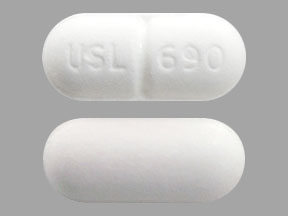Ethacrynic Acid Dosage
Medically reviewed by Drugs.com. Last updated on Aug 14, 2023.
Applies to the following strengths: 25 mg; 50 mg
Usual Adult Dose for:
Usual Pediatric Dose for:
Additional dosage information:
Usual Adult Dose for Ascites
Oral:
50 to 200 mg orally per day in 1 to 2 divided doses; once effective diuresis has been achieved, adjust dose as needed in 25 to 50 mg increments to the minimum effective dose and give on a continuous or intermittent schedule.
Add-on dose: When adding this drug to an existing diuretic regimen, initial dose and dose changes should be in 25 mg increments.
Comments:
- Initial and maintenance doses as high as 200 mg twice a day may be required, mostly in patients with severe, refractory edema.
- Dose and frequency can usually be reduced once dry weight has been achieved.
- Intermittent dosing may consist of alternate daily dosing or more prolonged periods of diuretic therapy interspersed with rest periods.
Use: Management of edema when an agent with greater diuretic potential than those commonly employed is required for treatment of edema associated with congestive heart failure, liver cirrhosis, or renal disease, including nephrotic syndrome, or short-term management of ascites due to malignancy, idiopathic edema, or lymphedema.
IV:
50 mg (or 0.5 to 1 mg/kg) IV once; occasionally, a second dose at a new injection site may be required.
Comments: A single dose not exceeding 100 mg has been used in critical situations.
Use: When rapid onset of diuresis is desired (e.g., acute pulmonary edema) or when gastrointestinal absorption is impaired or oral medication is not practicable.
Usual Adult Dose for Edema
Oral:
50 to 200 mg orally per day in 1 to 2 divided doses; once effective diuresis has been achieved, adjust dose as needed in 25 to 50 mg increments to the minimum effective dose and give on a continuous or intermittent schedule.
Add-on dose: When adding this drug to an existing diuretic regimen, initial dose and dose changes should be in 25 mg increments.
Comments:
- Initial and maintenance doses as high as 200 mg twice a day may be required, mostly in patients with severe, refractory edema.
- Dose and frequency can usually be reduced once dry weight has been achieved.
- Intermittent dosing may consist of alternate daily dosing or more prolonged periods of diuretic therapy interspersed with rest periods.
Use: Management of edema when an agent with greater diuretic potential than those commonly employed is required for treatment of edema associated with congestive heart failure, liver cirrhosis, or renal disease, including nephrotic syndrome, or short-term management of ascites due to malignancy, idiopathic edema, or lymphedema.
IV:
50 mg (or 0.5 to 1 mg/kg) IV once; occasionally, a second dose at a new injection site may be required.
Comments: A single dose not exceeding 100 mg has been used in critical situations.
Use: When rapid onset of diuresis is desired (e.g., acute pulmonary edema) or when gastrointestinal absorption is impaired or oral medication is not practicable.
Usual Pediatric Dose for Edema
Less than 1 year: Contraindicated
1 year or older:
- Initial dose: 25 mg orally
- Maintenance dose: May adjust dose as needed in 25 mg increments.
- Use: Management of edema when an agent with greater diuretic potential than those commonly employed is required for short-term management of edema associated with congenital heart disease or nephrotic syndrome in hospitalized patients.
Renal Dose Adjustments
Contraindicated in patients with anuria.
If increasing electrolyte imbalance, azotemia, and/or oliguria occur during treatment of severe, progressive renal disease: Discontinue this drug.
Liver Dose Adjustments
Use with caution
Dose Adjustments
Oral doses can be increased by 25 to 50 mg/day.
Most patients respond to 50 to 100 mg/day.
A second IV dose can be administered in 6 to 8 hours.
Precautions
Safety and efficacy of oral and parenteral use have not been established in infants.
Safety and efficacy of IV use has not been established in patients younger than 18 years.
Consult WARNINGS section for additional precautions.
Dialysis
Data not available
Other Comments
IV Administration advice: Administer slowly through the tubing of a running infusion or by direct IV injection over a period of several minutes; do not give subcutaneously or intramuscularly.
IV Reconstitution/preparation techniques: To reconstitute the dry material, add 50 mL of sodium chloride injection or 5% dextrose injection to the vial; 5% dextrose injection solutions with a pH less than 5 are not recommended.
IV compatibility: Do not mix the solution of this drug with whole blood or its derivatives.
Monitoring:
- Metabolic: Serum electrolytes, carbon dioxide, and BUN frequently during early therapy and periodically thereafter; patient weight should be measured before and during treatment with this drug.
More about ethacrynic acid
- Check interactions
- Compare alternatives
- Pricing & coupons
- Reviews (1)
- Drug images
- Side effects
- Dosage information
- During pregnancy
- Drug class: loop diuretics
- Breastfeeding
- En español
Patient resources
- Ethacrynic acid drug information
- Ethacrynate sodium (Advanced Reading)
- Ethacrynic acid (Advanced Reading)
Other brands
Professional resources
- Ethacrynic Acid monograph
- Ethacrynate Sodium Injection (FDA)
- Ethacrynic Acid (FDA)
- Ethacrynic Sodium Injection (FDA)
Other brands
Related treatment guides
Further information
Always consult your healthcare provider to ensure the information displayed on this page applies to your personal circumstances.

